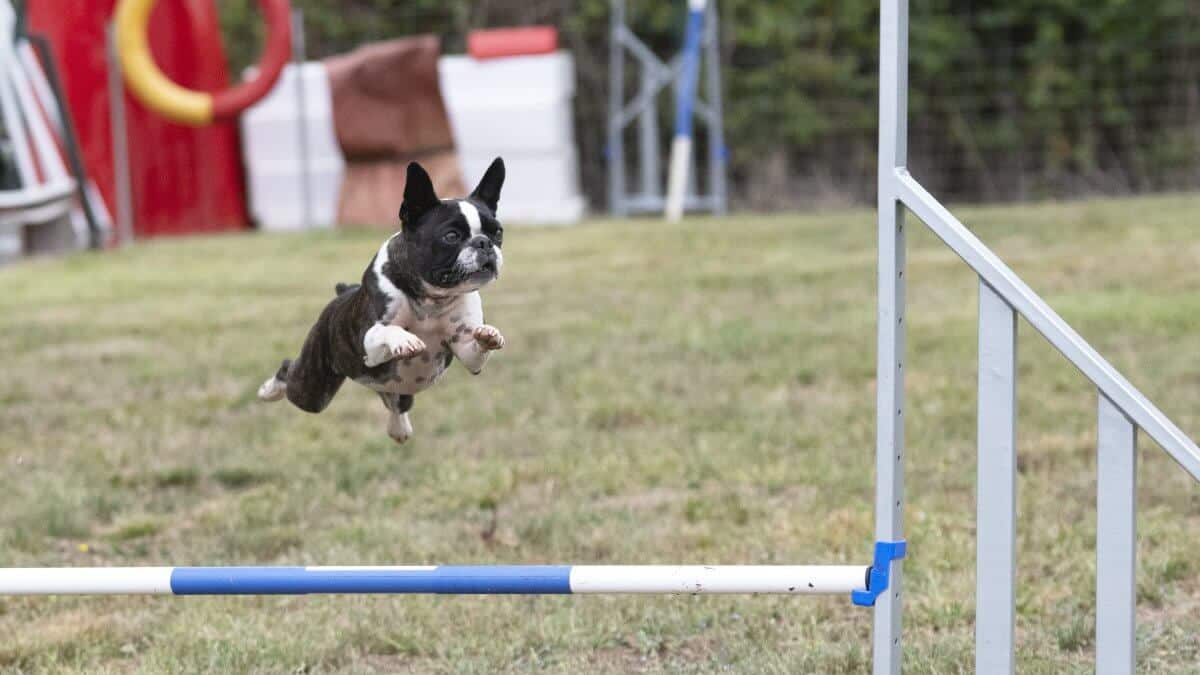


Home » Genetic George’s Monthly Musings: They May Be Called Non-Sporting, Yet They’re Fully Entertaining (Sporting)

Knock, Knock.
Who’s there?
Show.
Show who?
SHOWSIGHT you read this article to learn more about this amazing Group!
Q: Why did the Non-Sporting dog bring a magazine to the dog show?
A: Because he wanted to “Show Sight” what all the barking was about!
Today, we dive headfirst into the wonderfully quirky realm of the Non-Sporting Group—those canine oddballs that you could say defy classification. But first, a little insight from my trusty companions (and co-writers), Charlie the Boston Terrier and Mary the Brussels Griffon, who always have plenty to say about this “miscellaneous but magnificent” Group.
Charlie, never one to be modest, likes to remind me that Boston Terriers are, in fact, America’s gentlemen. “I’m a diplomat,” he often says. “I charm everyone – dogs, humans, even the occasional NY squirrel.” Meanwhile, Mary, with her scruffy yet regal Griffon confidence, adds, “Charlie’s charm doesn’t extend to ball-fetch time. The last time we were at the park, I’m pretty sure he tried to negotiate with a tree.”
Both Charlie and Mary’s antics highlight the wonderful diversity within all breed Groups, but none moreso than the Non-Sporting category. These breeds, often defined by their individuality, bring unique challenges and joys to breeders and owners. And, as always, genetics plays a crucial role in understanding and nurturing their quirks.
Despite their name, many Non-Sporting breeds are anything but inactive. The term “non-sporting” can be misleading because these dogs aren’t classified based on a specific job like hunting or herding. Instead, they possess a rich variety of talents and histories – from guarding to companionship, and even sporting activities. In fact, some Non-Sporting breeds excel in Agility and other canine sports.
From the elegant Standard Poodle to the spotted Dalmatian, Non-Sporting dogs are united by their uniqueness. Genetic testing helps to uncover the hereditary traits and potential health risks hidden beneath this diversity.
Health issues can be a game of roulette for Non-Sporting breeds due to their diverse genetic backgrounds. Breeders need to be vigilant about genetic disorders. For instance, Dalmatians are prone to urinary stones due to a genetic predisposition to hyperuricemia. A simple genetic test can identify carriers and help breeders make informed decisions to reduce the prevalence of this issue.
Charlie chimes in. “See? Testing isn’t just a science experiment; it’s about making sure I stay charming and healthy for years to come,” he exclaims. “No one wants a genetically untested, cranky Boston Terrier.”
Mary rolls her eyes but agrees. “Cranky or not, nobody can resist his ears and screw tail,” she declares. “But he’s right—knowledge
is power.”
Genetic testing isn’t just about preventing disease; it’s also a window into what makes each breed special. Coat type, color, and even temperament can be influenced by genetics. The distinctive blue-grey coat of the Kerry Blue Terrier, for example, is tied to specific genes that breeders have carefully maintained over generations.
“Imagine if I had a blue coat instead of black and white,” Charlie muses. “I’d be unstoppable.”
“You’re already enough of a handful,” Mary replies. “No one needs a supercharged blue Charlie.”
Breeders can use genetic testing to predict these traits, ensuring that Breed Standards are upheld while keeping an eye on genetic diversity to prevent inbreeding.
Yes, even behavior has a genetic component. Studies show that certain breeds have a higher likelihood of exhibiting specific behaviors based on their genetic makeup. Chinooks, a rare and versatile breed known for their gentle nature and work ethic, often inherit these traits from carefully curated bloodlines. Genetic testing for IVM/DR1 (a multi-drug resistance mutation) and Collie Eye Anomaly is essential to keep Chinooks healthy and thriving. These tests help breeders identify at-risk dogs and plan matings accordingly.
Mary, ever the pragmatist, says, “I’m not sure you need a test to know that some dogs are just naturally bossy. Exhibit A: Charlie.”
Charlie puffs out his chest. “Bossy or leader?” he asks. “I’ll let the readers decide.”
Let’s give a well-deserved bark-out to a few breeds that deserve more recognition and are highlighted in this month’s issue.
The Plott Hound: While not in the Non-Sporting Group, this loyal and courageous breed deserves a mention. Originally bred for hunting big game, Plott Hounds are athletic yet gentle with their families. Genetic testing for conditions like PRCD-PRA (Progressive Retinal Atrophy) and Degenerative Myelopathy (DGMY) is crucial to maintaining their health and longevity.
The Leonberger: This large, gentle breed is prone to certain genetic health conditions. Genetic testing helps to identify these risks, enabling breeders to reduce disease prevalence and owners to manage early symptoms effectively. Key genetic tests include Leonberger Polyneuropathy (LPN1 and LPN2), which causes muscle weakness and mobility loss, and Degenerative Myelopathy (DM), a spinal cord disease leading to paralysis. Early detection of these disorders allows for preventive care and informed breeding. Testing for hip and elbow dysplasia helps breeders reduce the risk of arthritis and joint pain. Screening for dilated cardiomyopathy (DCM), a heart condition, aids in early intervention to prevent heart failure. Eye tests for Progressive Retinal Atrophy (PRA) help to preserve vision by preventing breeding of affected dogs.
Other tests like Hyperuricosuria (HUU) and emerging markers for osteosarcoma (bone cancer) inform dietary and lifestyle changes to mitigate risks. Additionally, genetic diversity testing helps to maintain a healthy gene pool, reducing hereditary disease risks. These tests improve breeding decisions, disease prevention, and overall Leonberger health. Early detection and management can extend lifespan, enhance quality of life, and reduce costly emergency treatments, making genetic testing invaluable for this noble breed.
The Kerry Blue Terrier: Known for their striking blue coat and tenacious spirit, this breed’s history includes farm work, guarding, and even police duties. Genetic tests such as Degenerative Myelopathy (DGMY), Canine Multiple System Degeneration, and Factor XI Deficiency help breeders screen for hereditary risks. Mary, always the advocate for smart choices, recommends using Orivet for these tests. “Why settle for less when you can have the best?” she quips with a knowing look.
With advancements in genetic technology, breeders have more tools than ever to ensure the health and well-being of their dogs. Full Breed Profiles provide detailed insights into inherited diseases, traits, and even ancestry.
Service providers like Orivet and Paw Print Genetics are at the forefront of these advancements, offering comprehensive testing solutions. Orivet’s Full Breed Profile is a favorite among breeders, as it includes tests for diseases, traits, and parentage verification all in one package. With a focus on empowering breeders to make informed decisions, Orivet is known for its accuracy and breed-specific services. Did you know that all of Orivet’s Full Breed Profiles include a DNA Profile/Fingerprint? All delivered with an ISAG standard!
Meanwhile, Paw Print Genetics has built a reputation for reliability and robust customer support, specializing in breed panels that target key genetic risks. Their clear result reports and commitment to research have made them another trusted name in the industry.
These providers play a vital role in helping breeders maintain Breed Standards and protect genetic diversity. Through testing services like these, breeders can reduce the risk of inherited disorders and promote healthier, happier dogs. Whether you’re screening for conditions like PRCD-PRA, DM, or coat color genetics, the tools are readily available to give breeders the edge they need to ensure responsible breeding practices.
But as Charlie points out, “All the science in the world won’t stop Mary from hogging the best spot on the couch.”
“It’s called seniority,” Mary counters. “Or maybe just superior planning.”
Their banter aside, there’s truth in that statement. Genetics gives us knowledge, but it’s up to breeders and owners to apply it wisely. Testing helps with planning for healthier litters, reducing the risk of inherited disorders, and maintaining the traits that make each breed unique.
As we wrap up this month’s installment, I’m reminded of why I fell in love with this work in the first place. Each dog is a walking (or zooming) masterpiece of genetic coding. Non-Sporting breeds, with their wide variety of traits, embody that diversity beautifully.
Charlie and Mary have the last word, of course. “We’re more than just our DNA,” Charlie declares. “But it sure helps to have good genes.”
Mary nods. “And good company.”
Until next time, keep exploring the world of genetics and celebrating the dogs that make our lives complete. Whether you’re breeding, rescuing, or just loving your furry friend, remember: knowledge is the key to healthier, happier pups.
